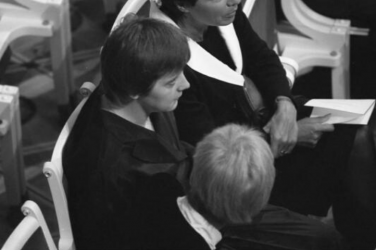E&M author Nichole Wanjirũ takes us along to a World Press Photo exhibition and argues how a white, Western-centric point of view continues to shape how we see and talk about race. Delving into personal experiences, she recounts what it means to live, and live in Europe as a racialised and hybridised subject.
The political is personal
I visited the World Press Photo exhibition in Amsterdam following a friend’s recommendation. While I have never attended their exhibitions, I am always wary of such “cultural events”. To my lack of surprise, I saw exactly what I expected.
The exhibition began with the most dramatic and unfortunate photographs, with images of (mostly) black and brown bodies experiencing various afflictions. Conflict, war, hunger, essentially, “contemporary issues”; typical images of despair that the West is used to seeing in distantly deprived nations. The deeper I went, the more nuanced the photos became. This led me to question why the images of brown and black bodies were more cavalier in their need to show Middle Eastern suffering, African suffering etc.
In the photographs depicting Sudan, Algeria, China, Egypt, Kenya, Syria, Venezuela, Afghanistan, and Iraq, it was interesting to see that all the pictures were taken by outsiders and over 90% of them by Western men. The suffering was blatantly obvious, through portrayals of people in tattered clothing, intubated children; very little was left to the imagination, with little to no nuance. There were a few exceptions. These included images taken by a female Ethiopian journalist covering an air crash site. This was also ironically one of the only images where white pain was explicitly depicted through imagery whereby a person who I assume is a Westerner mourned someone they lost. The other exception was an image from Armenia which also lacked the nuance of the next photos I saw. The images from the US, Australia, Russia, and Lithuania were all taken by insiders of the countries.
The images used to depict stories of events happening in places that mattered to the photojournalists were taken with a lot more respect of their subjects. A great example was a photograph taken in California during the wildfires. Children are pictured, however, they are all healthy-looking, unharmed, relatively normal. Nevertheless, the viewer can still understand through the text accompanying the photo as well as the thick smog and orange hue image that this is no ordinary picture; there was enough visible to portray the seriousness of the harm these fires were causing.
As a Kenyan who has grown up in both Kenya and Ethiopia, I deeply reflected on the photos that came from there, and while I noted that the photograph depicting the terrorist attack in Nairobi was indeed nuanced, I also remembered that, following the attack, Western newspapers were heavily criticised for again so recklessly depicting images of body parts and dead people. This type of imagery is almost never used to portray white bodies. Just think of the 9/11 coverage and how respectful the photojournalism was.
This made me question the exhibition. To what extent can outsiders leave out their internal biases in not just photojournalism but in telling stories? Is it enough to simply own a camera and shoot? I think not. I also questioned if are there no capable photojournalists from Kenya, Iraq, Egypt and Syria who could have participated in this exhibition? What does this say about the accessibility of the exhibition? There is something eerily disturbing about a group of mostly white men coming to take images of distant Others, and, in addition, handing out prizes for “best picture”, whilst displaying them to white gazes of Westerners who can come and “ooh” and “aah” at all the horrible madness that happens outside of the West for a mere €12.50. As if there are no internal issues that were very well not represented at the exhibition.
Because it is not just the fact that stories are told that is important, but also who can tell these stories, why these stories need to be told, and for what purpose.
To those who argue that such exhibitions are truly concerned with educating people about what happens in the world; I ask: where is this energy when in Ethiopia, for almost a year now, certain ethnic groups continue to be massacred under the current regime whilst the West hands out a Nobel Peace Prize to the Prime Minster? Where was this energy and concern for Cameroon, Yemen, Nigeria, Somalia (too many to mention) in times of major internal conflicts, when they were covered by no more than one-liners in major news outlets or completely neglected by ‘World News’ reels.
Do you actually care about the rest of the world or, on some very perverse level, is viewing the suffering of the Other a way to remind yourself “good thing I’m here in Amsterdam, my struggles are not so bad”? Such exhibitions are performative and, in my not so popular opinion, I really question who do these photographs really serve? What they are doing is upholding the current hegemonic discourses about the importance of circular economies, the concerning rise of fascism, the pangolin crisis, the melting ice caps (the other themed photographs). I am in no way saying that these topics do not matter – they do. I’m just stating that those who choose what is important and when to focus on what need to be critically reflected upon. Because it is not just the fact that stories are told that is important, but also who can tell these stories, why these stories need to be told, and for what purpose.
The personal is political
As a black African woman who has now spent 5 years in the Netherlands, I often find myself having to adjust my behaviour to appeal to the white gaze. Whether this is having a debate on how racist Zwarte-Piet is after literally being derogatively called the name on multiple occasions, or whether this means having to defend myself when I’m called a traitor for dating white men, or having to respond to someone who believes that I am taking a conversation to a “racial place” when my literal existence here is indeed often racial; from being followed around at Bijenkorf [Dutch department store] until they hear my eloquent accent to conclude that I am not an actual threat, to having a white man help me pick up an item I dropped only to later feel my presence as a threat as we cycled in the same direction and he kept looking back only to stop aside and let me pass to remind me that I am indeed a threat – it was 3pm on a summer afternoon. Whether it is my black friend’s image which is to this day being used by the University of Amsterdam to advertise “diversity” when they “asked for his consent” yet refuse to respond to his messages regarding payment which was promised. Essentially he has been left on read, his body evidently does not matter to the institution, but I assure you, his money did.
It is important to reiterate that such subjects are not up for “debate” where you say “let me just play devil’s advocate”. I can guarantee that the devil does not need any more advocates especially when the topic at hand is basic human experience that is worthy of respect.
Institutions maintain that they are so open to inclusivity and encouraging diversity but continue to utilise black and brown bodies for their benefit – this is exhausting.
The only difference between you and me is that I am forced to adjust to your rules that you cannot see.
My name is Nichole Wanjiru and I have been attempting to drop ‘Nichole’ for the past few years as it is a part of my identity that reminds me of my existence as a colonised subject. That I am not Kenyan enough, that I do not know my history because the British legacy is sustained in my education. I have tried to use Wanjiru as a first name but the number of people who butcher my identity because my name is “just too hard to pronounce” is ridiculous. This is senseless as they can comfortably pronounce all kinds of Germanic names and I too have learned how to pronounce them. I contend that my name is not difficult to pronounce; you just don’t respect my existence enough to learn how to pronounce it. And no, you cannot “just call me…”.
I have realised that I cannot escape my hybridised identity and I do not need to. It is in the way I speak, the way I view and interact with the world. I am every part Kenyan as I am a remnant of British colonialism. I speak English better than my own mother tongue. I just wish that many in the Netherlands, and in the West generally would also accept that just like I need not escape my hybridity, they too cannot escape their past. It is not an attack, but conversations and such exhibitions would be a lot less performative if they offered deeper reflections and more critical considerations of how our histories and cultures continually shape our identities and our perceptions of the world. It is in how we interact with the world around us whether we decide to see it or not.
The white gaze is inescapable. This shows in the way we treat and depict the Other. I’m asking that we have more constructive conversations instead of seeing the Other as distant and disconnected. It means looking into your history and wondering how your “golden years” came to be so golden. It means recognising that you too are a hybridised subject, the only difference between you and me is that I am forced to adjust to your rules that you cannot see. When you live in a world that is defined solely through your lenses, then anything that counters that is seen as a challenge to your worldview and thus confronts reality as you have come to define it. This is where we need to move the conversation. Anything else is performativity.
Cover photo: Deanna J on Unsplash, Unsplash license






